Role of Artificial Intelligence in Wealth Management through Investment in Mutual Funds
VerifiedAdded on 2023/06/07
|16
|5606
|129
AI Summary
This research report explores the role of artificial intelligence in wealth management through investment in mutual funds. It covers the methods and technologies used for investment decisions, mutual funds managed by AI, and benefits of AI in wealth management. The report also discusses the challenges and limitations of AI in mutual funds investment management.
Contribute Materials
Your contribution can guide someone’s learning journey. Share your
documents today.

Major Assignment - Research report
MAF702 Financial Markets 2018
MAF702 Financial Markets 2018
Secure Best Marks with AI Grader
Need help grading? Try our AI Grader for instant feedback on your assignments.

TABLE OF CONTENTS
ABSTRACT...............................................................................................................................3
Introduction................................................................................................................................3
Research topic........................................................................................................................3
Background of the study........................................................................................................3
Research aim..........................................................................................................................4
Research questions.................................................................................................................4
The significance of the study.................................................................................................4
Structure.................................................................................................................................4
Literature review........................................................................................................................5
Role of artificial intelligence in wealth management............................................................5
Methods and technologies used for investment decisions in mutual funds...........................6
Mutual funds managed by artificial intelligence....................................................................7
Sprott BUZZ Social Media Insights ETF...........................................................................8
The Global X Robotics & Artificial Intelligence ETF (BOTZ).........................................9
ARK Industrial Innovation ETF.........................................................................................9
Robo Global Robotics and Automation Index...................................................................9
Benefits of the introduction of artificial intelligence in wealth management through
investment in mutual funds....................................................................................................9
Methodology............................................................................................................................10
Research design....................................................................................................................10
Data collection.....................................................................................................................10
Data analysis........................................................................................................................11
Findings and conclusion...........................................................................................................11
References................................................................................................................................14
ABSTRACT...............................................................................................................................3
Introduction................................................................................................................................3
Research topic........................................................................................................................3
Background of the study........................................................................................................3
Research aim..........................................................................................................................4
Research questions.................................................................................................................4
The significance of the study.................................................................................................4
Structure.................................................................................................................................4
Literature review........................................................................................................................5
Role of artificial intelligence in wealth management............................................................5
Methods and technologies used for investment decisions in mutual funds...........................6
Mutual funds managed by artificial intelligence....................................................................7
Sprott BUZZ Social Media Insights ETF...........................................................................8
The Global X Robotics & Artificial Intelligence ETF (BOTZ).........................................9
ARK Industrial Innovation ETF.........................................................................................9
Robo Global Robotics and Automation Index...................................................................9
Benefits of the introduction of artificial intelligence in wealth management through
investment in mutual funds....................................................................................................9
Methodology............................................................................................................................10
Research design....................................................................................................................10
Data collection.....................................................................................................................10
Data analysis........................................................................................................................11
Findings and conclusion...........................................................................................................11
References................................................................................................................................14
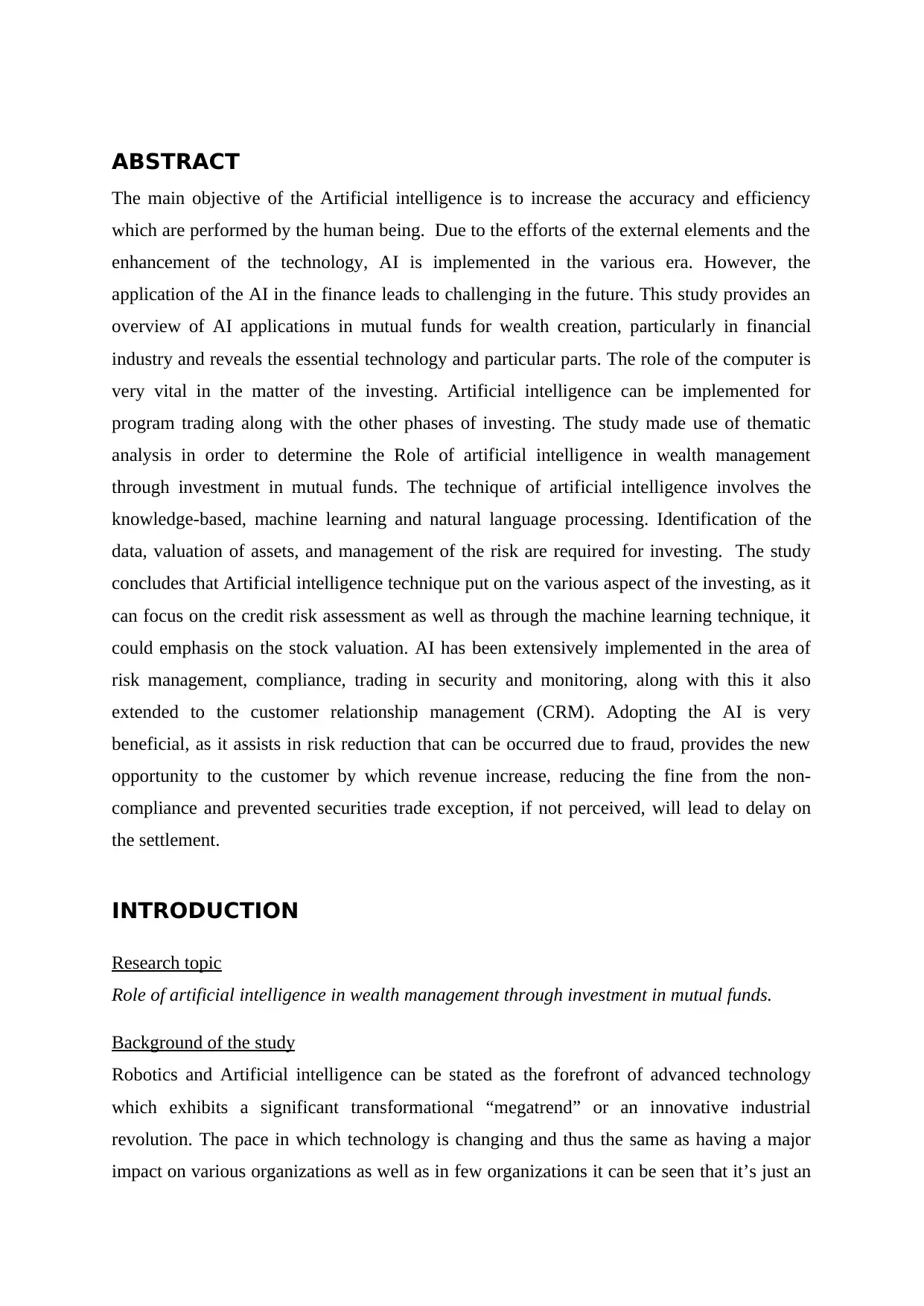
ABSTRACT
The main objective of the Artificial intelligence is to increase the accuracy and efficiency
which are performed by the human being. Due to the efforts of the external elements and the
enhancement of the technology, AI is implemented in the various era. However, the
application of the AI in the finance leads to challenging in the future. This study provides an
overview of AI applications in mutual funds for wealth creation, particularly in financial
industry and reveals the essential technology and particular parts. The role of the computer is
very vital in the matter of the investing. Artificial intelligence can be implemented for
program trading along with the other phases of investing. The study made use of thematic
analysis in order to determine the Role of artificial intelligence in wealth management
through investment in mutual funds. The technique of artificial intelligence involves the
knowledge-based, machine learning and natural language processing. Identification of the
data, valuation of assets, and management of the risk are required for investing. The study
concludes that Artificial intelligence technique put on the various aspect of the investing, as it
can focus on the credit risk assessment as well as through the machine learning technique, it
could emphasis on the stock valuation. AI has been extensively implemented in the area of
risk management, compliance, trading in security and monitoring, along with this it also
extended to the customer relationship management (CRM). Adopting the AI is very
beneficial, as it assists in risk reduction that can be occurred due to fraud, provides the new
opportunity to the customer by which revenue increase, reducing the fine from the non-
compliance and prevented securities trade exception, if not perceived, will lead to delay on
the settlement.
INTRODUCTION
Research topic
Role of artificial intelligence in wealth management through investment in mutual funds.
Background of the study
Robotics and Artificial intelligence can be stated as the forefront of advanced technology
which exhibits a significant transformational “megatrend” or an innovative industrial
revolution. The pace in which technology is changing and thus the same as having a major
impact on various organizations as well as in few organizations it can be seen that it’s just an
The main objective of the Artificial intelligence is to increase the accuracy and efficiency
which are performed by the human being. Due to the efforts of the external elements and the
enhancement of the technology, AI is implemented in the various era. However, the
application of the AI in the finance leads to challenging in the future. This study provides an
overview of AI applications in mutual funds for wealth creation, particularly in financial
industry and reveals the essential technology and particular parts. The role of the computer is
very vital in the matter of the investing. Artificial intelligence can be implemented for
program trading along with the other phases of investing. The study made use of thematic
analysis in order to determine the Role of artificial intelligence in wealth management
through investment in mutual funds. The technique of artificial intelligence involves the
knowledge-based, machine learning and natural language processing. Identification of the
data, valuation of assets, and management of the risk are required for investing. The study
concludes that Artificial intelligence technique put on the various aspect of the investing, as it
can focus on the credit risk assessment as well as through the machine learning technique, it
could emphasis on the stock valuation. AI has been extensively implemented in the area of
risk management, compliance, trading in security and monitoring, along with this it also
extended to the customer relationship management (CRM). Adopting the AI is very
beneficial, as it assists in risk reduction that can be occurred due to fraud, provides the new
opportunity to the customer by which revenue increase, reducing the fine from the non-
compliance and prevented securities trade exception, if not perceived, will lead to delay on
the settlement.
INTRODUCTION
Research topic
Role of artificial intelligence in wealth management through investment in mutual funds.
Background of the study
Robotics and Artificial intelligence can be stated as the forefront of advanced technology
which exhibits a significant transformational “megatrend” or an innovative industrial
revolution. The pace in which technology is changing and thus the same as having a major
impact on various organizations as well as in few organizations it can be seen that it’s just an
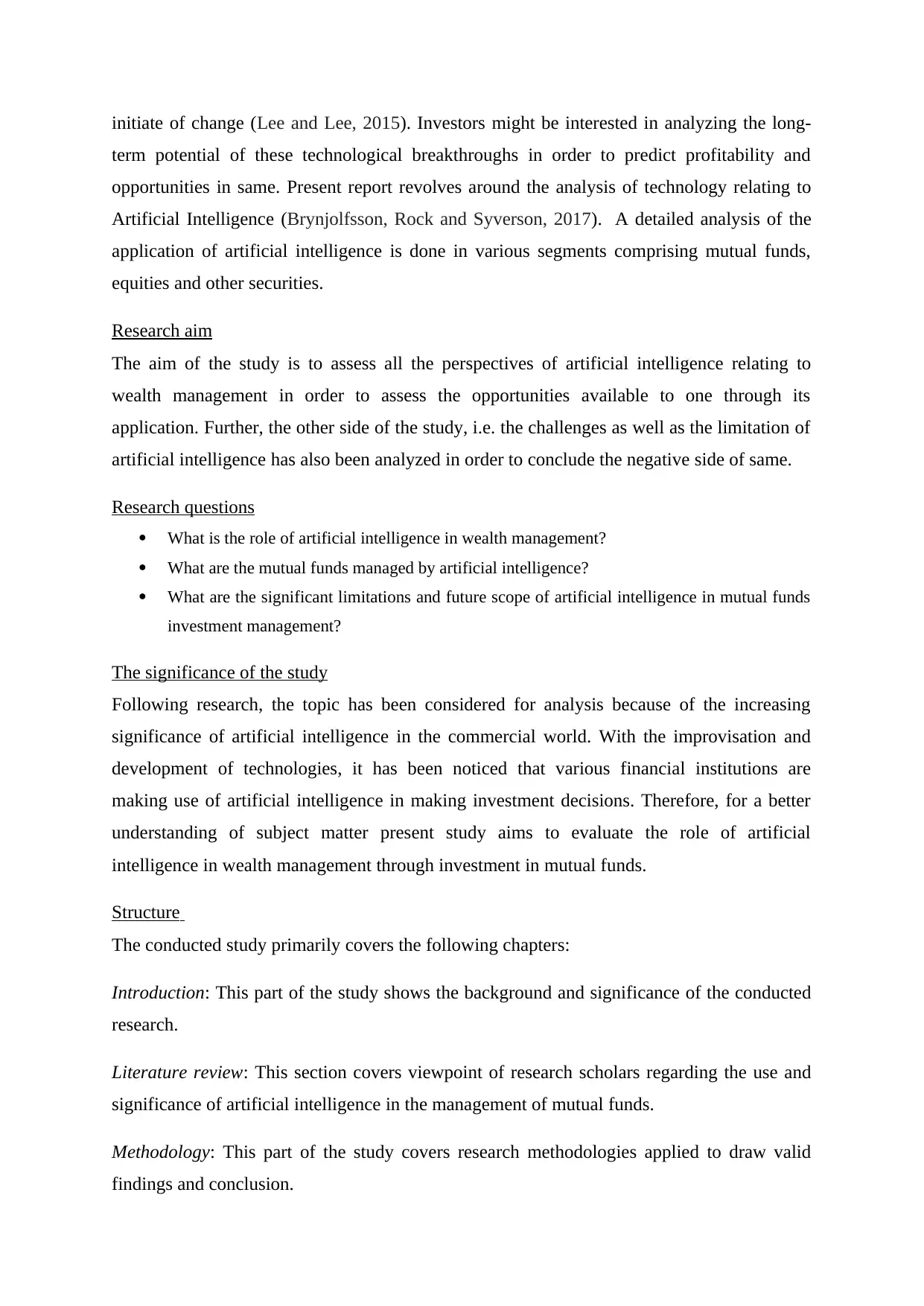
initiate of change (Lee and Lee, 2015). Investors might be interested in analyzing the long-
term potential of these technological breakthroughs in order to predict profitability and
opportunities in same. Present report revolves around the analysis of technology relating to
Artificial Intelligence (Brynjolfsson, Rock and Syverson, 2017). A detailed analysis of the
application of artificial intelligence is done in various segments comprising mutual funds,
equities and other securities.
Research aim
The aim of the study is to assess all the perspectives of artificial intelligence relating to
wealth management in order to assess the opportunities available to one through its
application. Further, the other side of the study, i.e. the challenges as well as the limitation of
artificial intelligence has also been analyzed in order to conclude the negative side of same.
Research questions
What is the role of artificial intelligence in wealth management?
What are the mutual funds managed by artificial intelligence?
What are the significant limitations and future scope of artificial intelligence in mutual funds
investment management?
The significance of the study
Following research, the topic has been considered for analysis because of the increasing
significance of artificial intelligence in the commercial world. With the improvisation and
development of technologies, it has been noticed that various financial institutions are
making use of artificial intelligence in making investment decisions. Therefore, for a better
understanding of subject matter present study aims to evaluate the role of artificial
intelligence in wealth management through investment in mutual funds.
Structure
The conducted study primarily covers the following chapters:
Introduction: This part of the study shows the background and significance of the conducted
research.
Literature review: This section covers viewpoint of research scholars regarding the use and
significance of artificial intelligence in the management of mutual funds.
Methodology: This part of the study covers research methodologies applied to draw valid
findings and conclusion.
term potential of these technological breakthroughs in order to predict profitability and
opportunities in same. Present report revolves around the analysis of technology relating to
Artificial Intelligence (Brynjolfsson, Rock and Syverson, 2017). A detailed analysis of the
application of artificial intelligence is done in various segments comprising mutual funds,
equities and other securities.
Research aim
The aim of the study is to assess all the perspectives of artificial intelligence relating to
wealth management in order to assess the opportunities available to one through its
application. Further, the other side of the study, i.e. the challenges as well as the limitation of
artificial intelligence has also been analyzed in order to conclude the negative side of same.
Research questions
What is the role of artificial intelligence in wealth management?
What are the mutual funds managed by artificial intelligence?
What are the significant limitations and future scope of artificial intelligence in mutual funds
investment management?
The significance of the study
Following research, the topic has been considered for analysis because of the increasing
significance of artificial intelligence in the commercial world. With the improvisation and
development of technologies, it has been noticed that various financial institutions are
making use of artificial intelligence in making investment decisions. Therefore, for a better
understanding of subject matter present study aims to evaluate the role of artificial
intelligence in wealth management through investment in mutual funds.
Structure
The conducted study primarily covers the following chapters:
Introduction: This part of the study shows the background and significance of the conducted
research.
Literature review: This section covers viewpoint of research scholars regarding the use and
significance of artificial intelligence in the management of mutual funds.
Methodology: This part of the study covers research methodologies applied to draw valid
findings and conclusion.
Secure Best Marks with AI Grader
Need help grading? Try our AI Grader for instant feedback on your assignments.
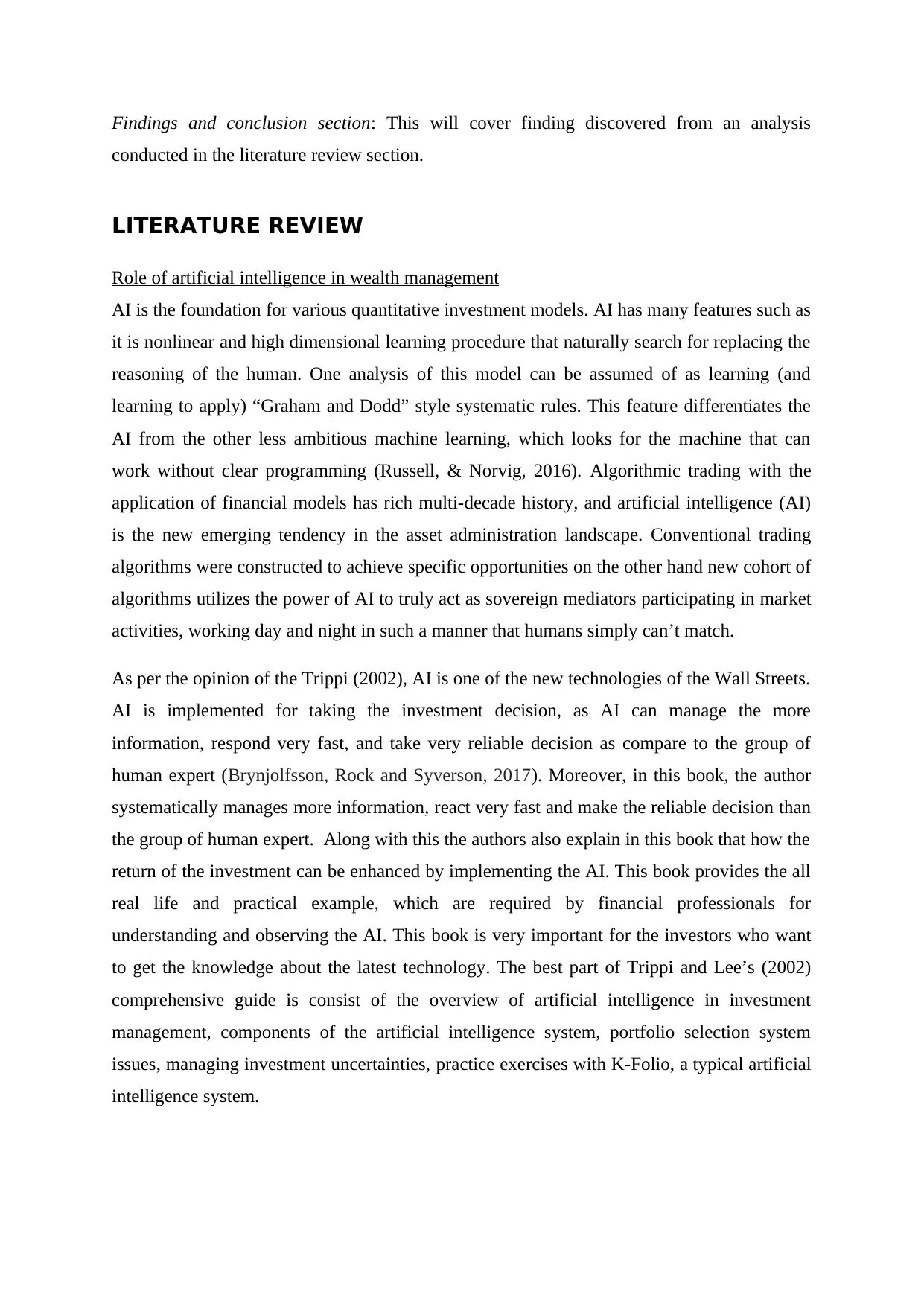
Findings and conclusion section: This will cover finding discovered from an analysis
conducted in the literature review section.
LITERATURE REVIEW
Role of artificial intelligence in wealth management
AI is the foundation for various quantitative investment models. AI has many features such as
it is nonlinear and high dimensional learning procedure that naturally search for replacing the
reasoning of the human. One analysis of this model can be assumed of as learning (and
learning to apply) “Graham and Dodd” style systematic rules. This feature differentiates the
AI from the other less ambitious machine learning, which looks for the machine that can
work without clear programming (Russell, & Norvig, 2016). Algorithmic trading with the
application of financial models has rich multi-decade history, and artificial intelligence (AI)
is the new emerging tendency in the asset administration landscape. Conventional trading
algorithms were constructed to achieve specific opportunities on the other hand new cohort of
algorithms utilizes the power of AI to truly act as sovereign mediators participating in market
activities, working day and night in such a manner that humans simply can’t match.
As per the opinion of the Trippi (2002), AI is one of the new technologies of the Wall Streets.
AI is implemented for taking the investment decision, as AI can manage the more
information, respond very fast, and take very reliable decision as compare to the group of
human expert (Brynjolfsson, Rock and Syverson, 2017). Moreover, in this book, the author
systematically manages more information, react very fast and make the reliable decision than
the group of human expert. Along with this the authors also explain in this book that how the
return of the investment can be enhanced by implementing the AI. This book provides the all
real life and practical example, which are required by financial professionals for
understanding and observing the AI. This book is very important for the investors who want
to get the knowledge about the latest technology. The best part of Trippi and Lee’s (2002)
comprehensive guide is consist of the overview of artificial intelligence in investment
management, components of the artificial intelligence system, portfolio selection system
issues, managing investment uncertainties, practice exercises with K-Folio, a typical artificial
intelligence system.
conducted in the literature review section.
LITERATURE REVIEW
Role of artificial intelligence in wealth management
AI is the foundation for various quantitative investment models. AI has many features such as
it is nonlinear and high dimensional learning procedure that naturally search for replacing the
reasoning of the human. One analysis of this model can be assumed of as learning (and
learning to apply) “Graham and Dodd” style systematic rules. This feature differentiates the
AI from the other less ambitious machine learning, which looks for the machine that can
work without clear programming (Russell, & Norvig, 2016). Algorithmic trading with the
application of financial models has rich multi-decade history, and artificial intelligence (AI)
is the new emerging tendency in the asset administration landscape. Conventional trading
algorithms were constructed to achieve specific opportunities on the other hand new cohort of
algorithms utilizes the power of AI to truly act as sovereign mediators participating in market
activities, working day and night in such a manner that humans simply can’t match.
As per the opinion of the Trippi (2002), AI is one of the new technologies of the Wall Streets.
AI is implemented for taking the investment decision, as AI can manage the more
information, respond very fast, and take very reliable decision as compare to the group of
human expert (Brynjolfsson, Rock and Syverson, 2017). Moreover, in this book, the author
systematically manages more information, react very fast and make the reliable decision than
the group of human expert. Along with this the authors also explain in this book that how the
return of the investment can be enhanced by implementing the AI. This book provides the all
real life and practical example, which are required by financial professionals for
understanding and observing the AI. This book is very important for the investors who want
to get the knowledge about the latest technology. The best part of Trippi and Lee’s (2002)
comprehensive guide is consist of the overview of artificial intelligence in investment
management, components of the artificial intelligence system, portfolio selection system
issues, managing investment uncertainties, practice exercises with K-Folio, a typical artificial
intelligence system.
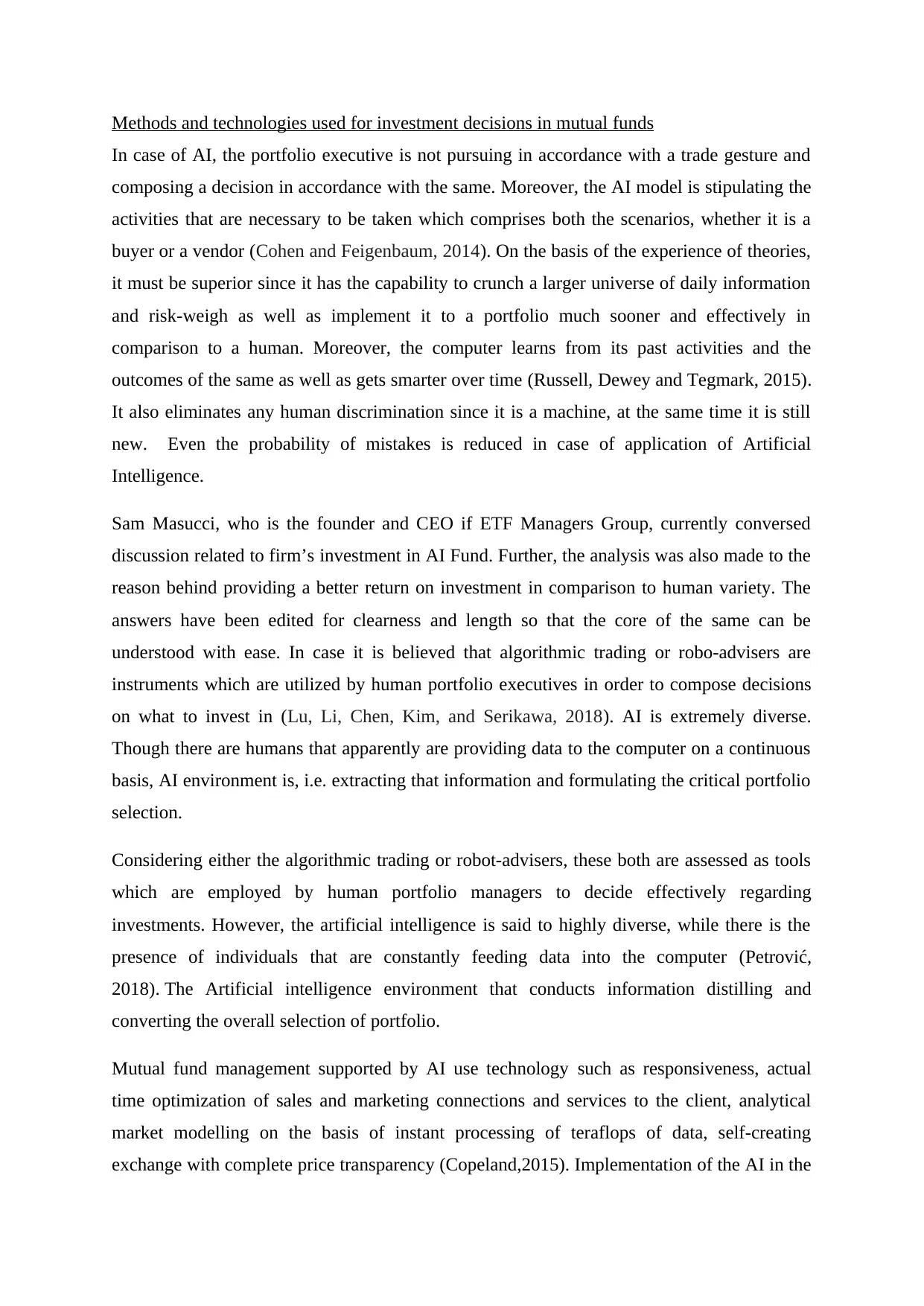
Methods and technologies used for investment decisions in mutual funds
In case of AI, the portfolio executive is not pursuing in accordance with a trade gesture and
composing a decision in accordance with the same. Moreover, the AI model is stipulating the
activities that are necessary to be taken which comprises both the scenarios, whether it is a
buyer or a vendor (Cohen and Feigenbaum, 2014). On the basis of the experience of theories,
it must be superior since it has the capability to crunch a larger universe of daily information
and risk-weigh as well as implement it to a portfolio much sooner and effectively in
comparison to a human. Moreover, the computer learns from its past activities and the
outcomes of the same as well as gets smarter over time (Russell, Dewey and Tegmark, 2015).
It also eliminates any human discrimination since it is a machine, at the same time it is still
new. Even the probability of mistakes is reduced in case of application of Artificial
Intelligence.
Sam Masucci, who is the founder and CEO if ETF Managers Group, currently conversed
discussion related to firm’s investment in AI Fund. Further, the analysis was also made to the
reason behind providing a better return on investment in comparison to human variety. The
answers have been edited for clearness and length so that the core of the same can be
understood with ease. In case it is believed that algorithmic trading or robo-advisers are
instruments which are utilized by human portfolio executives in order to compose decisions
on what to invest in (Lu, Li, Chen, Kim, and Serikawa, 2018). AI is extremely diverse.
Though there are humans that apparently are providing data to the computer on a continuous
basis, AI environment is, i.e. extracting that information and formulating the critical portfolio
selection.
Considering either the algorithmic trading or robot-advisers, these both are assessed as tools
which are employed by human portfolio managers to decide effectively regarding
investments. However, the artificial intelligence is said to highly diverse, while there is the
presence of individuals that are constantly feeding data into the computer (Petrović,
2018). The Artificial intelligence environment that conducts information distilling and
converting the overall selection of portfolio.
Mutual fund management supported by AI use technology such as responsiveness, actual
time optimization of sales and marketing connections and services to the client, analytical
market modelling on the basis of instant processing of teraflops of data, self-creating
exchange with complete price transparency (Copeland,2015). Implementation of the AI in the
In case of AI, the portfolio executive is not pursuing in accordance with a trade gesture and
composing a decision in accordance with the same. Moreover, the AI model is stipulating the
activities that are necessary to be taken which comprises both the scenarios, whether it is a
buyer or a vendor (Cohen and Feigenbaum, 2014). On the basis of the experience of theories,
it must be superior since it has the capability to crunch a larger universe of daily information
and risk-weigh as well as implement it to a portfolio much sooner and effectively in
comparison to a human. Moreover, the computer learns from its past activities and the
outcomes of the same as well as gets smarter over time (Russell, Dewey and Tegmark, 2015).
It also eliminates any human discrimination since it is a machine, at the same time it is still
new. Even the probability of mistakes is reduced in case of application of Artificial
Intelligence.
Sam Masucci, who is the founder and CEO if ETF Managers Group, currently conversed
discussion related to firm’s investment in AI Fund. Further, the analysis was also made to the
reason behind providing a better return on investment in comparison to human variety. The
answers have been edited for clearness and length so that the core of the same can be
understood with ease. In case it is believed that algorithmic trading or robo-advisers are
instruments which are utilized by human portfolio executives in order to compose decisions
on what to invest in (Lu, Li, Chen, Kim, and Serikawa, 2018). AI is extremely diverse.
Though there are humans that apparently are providing data to the computer on a continuous
basis, AI environment is, i.e. extracting that information and formulating the critical portfolio
selection.
Considering either the algorithmic trading or robot-advisers, these both are assessed as tools
which are employed by human portfolio managers to decide effectively regarding
investments. However, the artificial intelligence is said to highly diverse, while there is the
presence of individuals that are constantly feeding data into the computer (Petrović,
2018). The Artificial intelligence environment that conducts information distilling and
converting the overall selection of portfolio.
Mutual fund management supported by AI use technology such as responsiveness, actual
time optimization of sales and marketing connections and services to the client, analytical
market modelling on the basis of instant processing of teraflops of data, self-creating
exchange with complete price transparency (Copeland,2015). Implementation of the AI in the
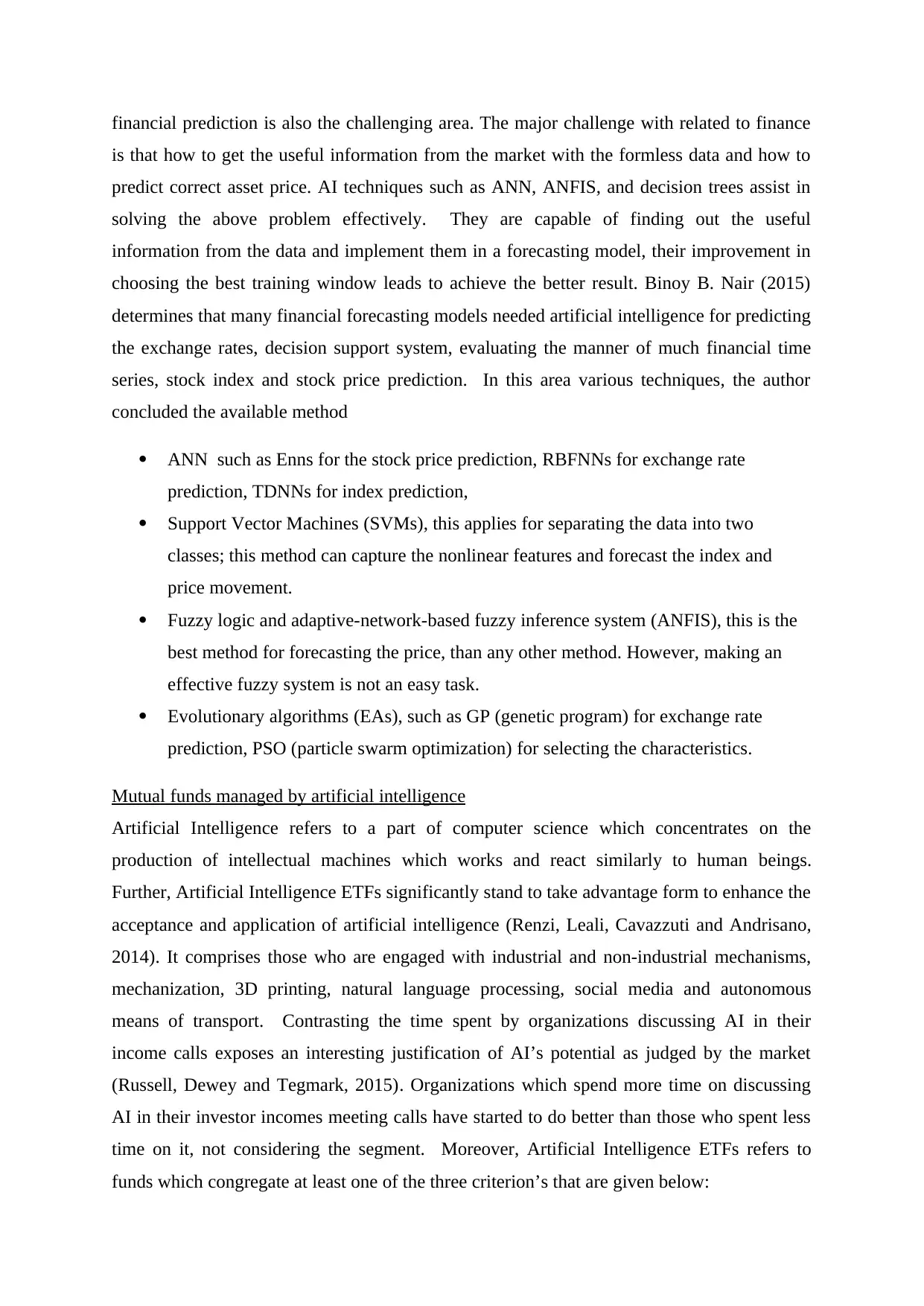
financial prediction is also the challenging area. The major challenge with related to finance
is that how to get the useful information from the market with the formless data and how to
predict correct asset price. AI techniques such as ANN, ANFIS, and decision trees assist in
solving the above problem effectively. They are capable of finding out the useful
information from the data and implement them in a forecasting model, their improvement in
choosing the best training window leads to achieve the better result. Binoy B. Nair (2015)
determines that many financial forecasting models needed artificial intelligence for predicting
the exchange rates, decision support system, evaluating the manner of much financial time
series, stock index and stock price prediction. In this area various techniques, the author
concluded the available method
ANN such as Enns for the stock price prediction, RBFNNs for exchange rate
prediction, TDNNs for index prediction,
Support Vector Machines (SVMs), this applies for separating the data into two
classes; this method can capture the nonlinear features and forecast the index and
price movement.
Fuzzy logic and adaptive-network-based fuzzy inference system (ANFIS), this is the
best method for forecasting the price, than any other method. However, making an
effective fuzzy system is not an easy task.
Evolutionary algorithms (EAs), such as GP (genetic program) for exchange rate
prediction, PSO (particle swarm optimization) for selecting the characteristics.
Mutual funds managed by artificial intelligence
Artificial Intelligence refers to a part of computer science which concentrates on the
production of intellectual machines which works and react similarly to human beings.
Further, Artificial Intelligence ETFs significantly stand to take advantage form to enhance the
acceptance and application of artificial intelligence (Renzi, Leali, Cavazzuti and Andrisano,
2014). It comprises those who are engaged with industrial and non-industrial mechanisms,
mechanization, 3D printing, natural language processing, social media and autonomous
means of transport. Contrasting the time spent by organizations discussing AI in their
income calls exposes an interesting justification of AI’s potential as judged by the market
(Russell, Dewey and Tegmark, 2015). Organizations which spend more time on discussing
AI in their investor incomes meeting calls have started to do better than those who spent less
time on it, not considering the segment. Moreover, Artificial Intelligence ETFs refers to
funds which congregate at least one of the three criterion’s that are given below:
is that how to get the useful information from the market with the formless data and how to
predict correct asset price. AI techniques such as ANN, ANFIS, and decision trees assist in
solving the above problem effectively. They are capable of finding out the useful
information from the data and implement them in a forecasting model, their improvement in
choosing the best training window leads to achieve the better result. Binoy B. Nair (2015)
determines that many financial forecasting models needed artificial intelligence for predicting
the exchange rates, decision support system, evaluating the manner of much financial time
series, stock index and stock price prediction. In this area various techniques, the author
concluded the available method
ANN such as Enns for the stock price prediction, RBFNNs for exchange rate
prediction, TDNNs for index prediction,
Support Vector Machines (SVMs), this applies for separating the data into two
classes; this method can capture the nonlinear features and forecast the index and
price movement.
Fuzzy logic and adaptive-network-based fuzzy inference system (ANFIS), this is the
best method for forecasting the price, than any other method. However, making an
effective fuzzy system is not an easy task.
Evolutionary algorithms (EAs), such as GP (genetic program) for exchange rate
prediction, PSO (particle swarm optimization) for selecting the characteristics.
Mutual funds managed by artificial intelligence
Artificial Intelligence refers to a part of computer science which concentrates on the
production of intellectual machines which works and react similarly to human beings.
Further, Artificial Intelligence ETFs significantly stand to take advantage form to enhance the
acceptance and application of artificial intelligence (Renzi, Leali, Cavazzuti and Andrisano,
2014). It comprises those who are engaged with industrial and non-industrial mechanisms,
mechanization, 3D printing, natural language processing, social media and autonomous
means of transport. Contrasting the time spent by organizations discussing AI in their
income calls exposes an interesting justification of AI’s potential as judged by the market
(Russell, Dewey and Tegmark, 2015). Organizations which spend more time on discussing
AI in their investor incomes meeting calls have started to do better than those who spent less
time on it, not considering the segment. Moreover, Artificial Intelligence ETFs refers to
funds which congregate at least one of the three criterion’s that are given below:
Paraphrase This Document
Need a fresh take? Get an instant paraphrase of this document with our AI Paraphraser

The funds which are particularly invested in organisations engaged with the creation
of new goods and services, technological enhancements into scientific research for
Artificial Intelligence.
The funds that consist of at least 25% of portfolio exposure to organisations that
invest large funds on AI Research and Development (R&D) expenditures. For
instance, Amazon, Tesla Motors, Apple and Alphabet.
Funds that utilizes AI methods in order to choose individual securities for enclosure in
the fund.
Further, AI comprising a capability to scrutinize data and even learn from it is believed
helpful in implementing some investing models, for example, elevated frequency trading as
well as in helping fund executives with tasks that rely on meetings and understanding reams
of information (Gil, Greaves, Hendler and Hirsh, 2014). Contrasting the time spent by
organizations discussing AI in their income calls exposes an interesting justification of AI’s
potential as judged by the market. Organizations which spend more time on discussing AI in
their investor incomes meeting calls have started to do better than those who spent less time
on it, not considering the segment.
Benefits of the introduction of artificial intelligence in wealth management through
investment in mutual funds
Financial institutions are pursuing innovative ways to use a large amount of data from all
over the world for taking the significant investment decision. Since the current business
intelligence is generally constructed on organized historical and present data, which are
existed within the firm, but now the enterprise seeks to use the rising unorganized data also.
By implementing the predictive analytics, artificial intelligence and machine learning
enterprise can find out patterns which are concealed in the organized and unorganized data
which assist in improving the correctness of key investment decision (Russell, Dewey and
Tegmark, 2015).
The innovative AI technology provides a solution to handle various real-world investment
portfolio administration issues, for example, vagueness and financial time-series prediction,
which was until now fundamentally controlled by experienced investors (Scherer, 2015). The
major results of this shift must be lower administration fees since the AI-based executives
have a very scalable offering as well as elevated returns since algorithms never snooze, so
they should make less error in comparison to the human beings (Mikhaylov, Esteve and
of new goods and services, technological enhancements into scientific research for
Artificial Intelligence.
The funds that consist of at least 25% of portfolio exposure to organisations that
invest large funds on AI Research and Development (R&D) expenditures. For
instance, Amazon, Tesla Motors, Apple and Alphabet.
Funds that utilizes AI methods in order to choose individual securities for enclosure in
the fund.
Further, AI comprising a capability to scrutinize data and even learn from it is believed
helpful in implementing some investing models, for example, elevated frequency trading as
well as in helping fund executives with tasks that rely on meetings and understanding reams
of information (Gil, Greaves, Hendler and Hirsh, 2014). Contrasting the time spent by
organizations discussing AI in their income calls exposes an interesting justification of AI’s
potential as judged by the market. Organizations which spend more time on discussing AI in
their investor incomes meeting calls have started to do better than those who spent less time
on it, not considering the segment.
Benefits of the introduction of artificial intelligence in wealth management through
investment in mutual funds
Financial institutions are pursuing innovative ways to use a large amount of data from all
over the world for taking the significant investment decision. Since the current business
intelligence is generally constructed on organized historical and present data, which are
existed within the firm, but now the enterprise seeks to use the rising unorganized data also.
By implementing the predictive analytics, artificial intelligence and machine learning
enterprise can find out patterns which are concealed in the organized and unorganized data
which assist in improving the correctness of key investment decision (Russell, Dewey and
Tegmark, 2015).
The innovative AI technology provides a solution to handle various real-world investment
portfolio administration issues, for example, vagueness and financial time-series prediction,
which was until now fundamentally controlled by experienced investors (Scherer, 2015). The
major results of this shift must be lower administration fees since the AI-based executives
have a very scalable offering as well as elevated returns since algorithms never snooze, so
they should make less error in comparison to the human beings (Mikhaylov, Esteve and
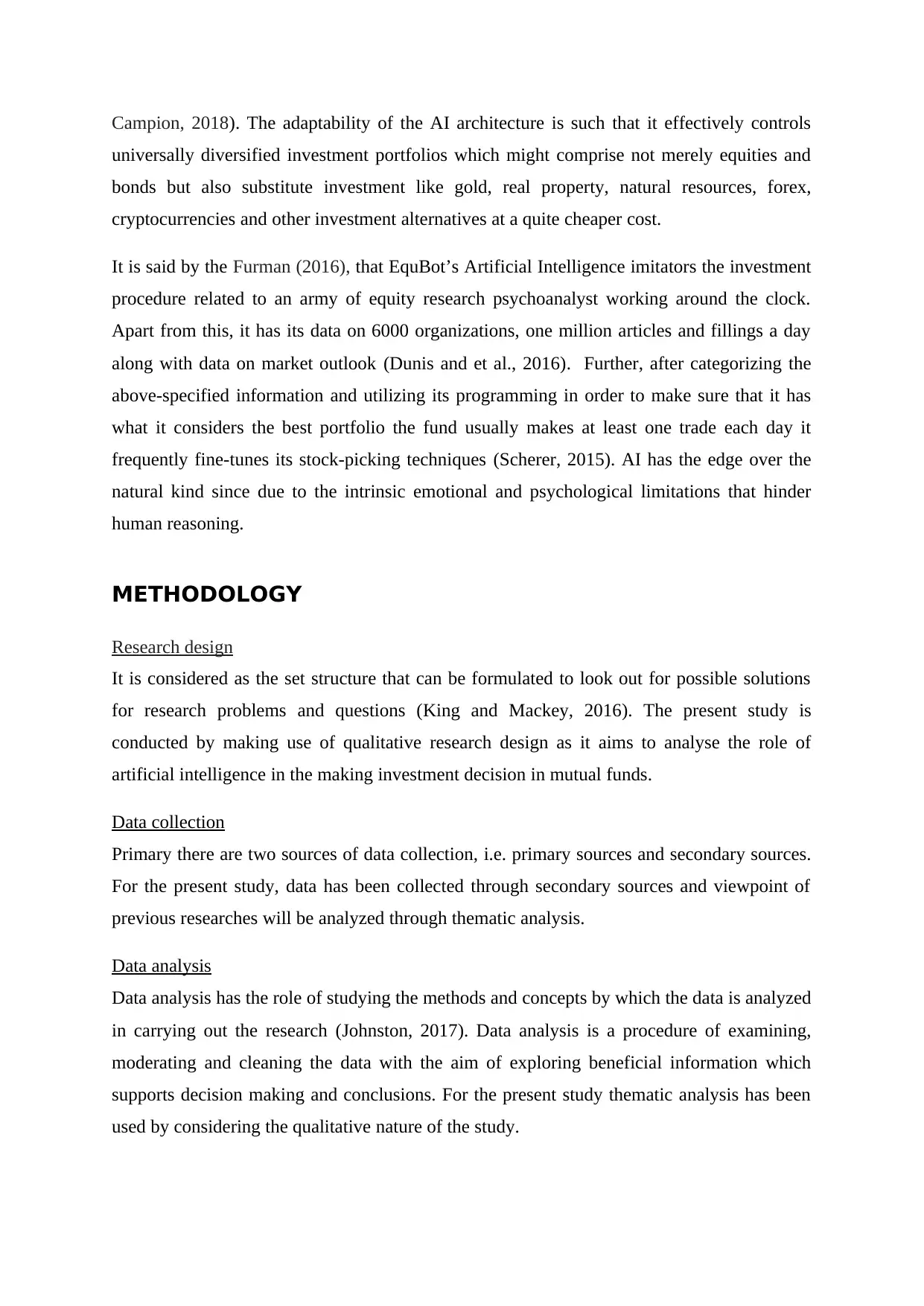
Campion, 2018). The adaptability of the AI architecture is such that it effectively controls
universally diversified investment portfolios which might comprise not merely equities and
bonds but also substitute investment like gold, real property, natural resources, forex,
cryptocurrencies and other investment alternatives at a quite cheaper cost.
It is said by the Furman (2016), that EquBot’s Artificial Intelligence imitators the investment
procedure related to an army of equity research psychoanalyst working around the clock.
Apart from this, it has its data on 6000 organizations, one million articles and fillings a day
along with data on market outlook (Dunis and et al., 2016). Further, after categorizing the
above-specified information and utilizing its programming in order to make sure that it has
what it considers the best portfolio the fund usually makes at least one trade each day it
frequently fine-tunes its stock-picking techniques (Scherer, 2015). AI has the edge over the
natural kind since due to the intrinsic emotional and psychological limitations that hinder
human reasoning.
METHODOLOGY
Research design
It is considered as the set structure that can be formulated to look out for possible solutions
for research problems and questions (King and Mackey, 2016). The present study is
conducted by making use of qualitative research design as it aims to analyse the role of
artificial intelligence in the making investment decision in mutual funds.
Data collection
Primary there are two sources of data collection, i.e. primary sources and secondary sources.
For the present study, data has been collected through secondary sources and viewpoint of
previous researches will be analyzed through thematic analysis.
Data analysis
Data analysis has the role of studying the methods and concepts by which the data is analyzed
in carrying out the research (Johnston, 2017). Data analysis is a procedure of examining,
moderating and cleaning the data with the aim of exploring beneficial information which
supports decision making and conclusions. For the present study thematic analysis has been
used by considering the qualitative nature of the study.
universally diversified investment portfolios which might comprise not merely equities and
bonds but also substitute investment like gold, real property, natural resources, forex,
cryptocurrencies and other investment alternatives at a quite cheaper cost.
It is said by the Furman (2016), that EquBot’s Artificial Intelligence imitators the investment
procedure related to an army of equity research psychoanalyst working around the clock.
Apart from this, it has its data on 6000 organizations, one million articles and fillings a day
along with data on market outlook (Dunis and et al., 2016). Further, after categorizing the
above-specified information and utilizing its programming in order to make sure that it has
what it considers the best portfolio the fund usually makes at least one trade each day it
frequently fine-tunes its stock-picking techniques (Scherer, 2015). AI has the edge over the
natural kind since due to the intrinsic emotional and psychological limitations that hinder
human reasoning.
METHODOLOGY
Research design
It is considered as the set structure that can be formulated to look out for possible solutions
for research problems and questions (King and Mackey, 2016). The present study is
conducted by making use of qualitative research design as it aims to analyse the role of
artificial intelligence in the making investment decision in mutual funds.
Data collection
Primary there are two sources of data collection, i.e. primary sources and secondary sources.
For the present study, data has been collected through secondary sources and viewpoint of
previous researches will be analyzed through thematic analysis.
Data analysis
Data analysis has the role of studying the methods and concepts by which the data is analyzed
in carrying out the research (Johnston, 2017). Data analysis is a procedure of examining,
moderating and cleaning the data with the aim of exploring beneficial information which
supports decision making and conclusions. For the present study thematic analysis has been
used by considering the qualitative nature of the study.

ANALYSIS
Changing technologies for management of mutual funds
Financial institutions are significantly changing such as changing demographics and
perspective of the customers, strict rules and regulations, vital digital technologies, and
increasing the competition from fintech companies. For solving the all above matter, banks
can work together with the fintech companies that give an innovative solution in the
environment of AI (Cohen, & Feigenbaum, (2014). Individual firms require modifying the
solution as per their investment strategy and procedure requirement. At the time of selecting
the solution, firms have to consider their data, administered learning requirement and
accuracy of the model. Banks can with the help of the AI and machine learning, can expand
their growth of the business as this technology assist to banks for better decision making.
Mutual funds of Australia managed through artificial intelligence:
Sprott BUZZ Social Media Insights ETF
It is a new exchanged based traded fund that is developed to serve exposure to the BUZZ
Social Media Insights Index; it tends to determine the US stock that is ranked at the highest
position in context with affirmative insight, inclusive of brand value perceptions and
discussion breadth from social media mention and etc. It brings a strong integration of big
data analytics with social media. It forms and manages strategies of the proprietary
quantitative portfolio on the basis of Big Data analytics models. It is a relatively new fund,
which was launched on April 18, 2016, and helps in tracking the buzz NextGen AI the US
Sentiment Leaders Index followed by the 76 well-known holdings via news articles and other
social media sources (BusinessWire, 2016).
The Global X Robotics & Artificial Intelligence ETF (BOTZ)
This fund seeks to make an investment in the firms that possibility compete to merit from
higher adoption and use of AI and robotics inclusive of the one engaged with non-industrial
robots, industrial robotics, autonomous vehicles and automation (Jocelyn Aspa, 2018). It
offers exposure of cross-sector to corporate operating to develop and produce AI and
robotics by a market cap opt and weighted index. It came into effect on September 12, 2016,
and provided exposure to the organizations engaged in the international automation and
industrial robotics. A huge investment has been made by the fund in the market like hardware
and software and managerial system of automated products and services.
Changing technologies for management of mutual funds
Financial institutions are significantly changing such as changing demographics and
perspective of the customers, strict rules and regulations, vital digital technologies, and
increasing the competition from fintech companies. For solving the all above matter, banks
can work together with the fintech companies that give an innovative solution in the
environment of AI (Cohen, & Feigenbaum, (2014). Individual firms require modifying the
solution as per their investment strategy and procedure requirement. At the time of selecting
the solution, firms have to consider their data, administered learning requirement and
accuracy of the model. Banks can with the help of the AI and machine learning, can expand
their growth of the business as this technology assist to banks for better decision making.
Mutual funds of Australia managed through artificial intelligence:
Sprott BUZZ Social Media Insights ETF
It is a new exchanged based traded fund that is developed to serve exposure to the BUZZ
Social Media Insights Index; it tends to determine the US stock that is ranked at the highest
position in context with affirmative insight, inclusive of brand value perceptions and
discussion breadth from social media mention and etc. It brings a strong integration of big
data analytics with social media. It forms and manages strategies of the proprietary
quantitative portfolio on the basis of Big Data analytics models. It is a relatively new fund,
which was launched on April 18, 2016, and helps in tracking the buzz NextGen AI the US
Sentiment Leaders Index followed by the 76 well-known holdings via news articles and other
social media sources (BusinessWire, 2016).
The Global X Robotics & Artificial Intelligence ETF (BOTZ)
This fund seeks to make an investment in the firms that possibility compete to merit from
higher adoption and use of AI and robotics inclusive of the one engaged with non-industrial
robots, industrial robotics, autonomous vehicles and automation (Jocelyn Aspa, 2018). It
offers exposure of cross-sector to corporate operating to develop and produce AI and
robotics by a market cap opt and weighted index. It came into effect on September 12, 2016,
and provided exposure to the organizations engaged in the international automation and
industrial robotics. A huge investment has been made by the fund in the market like hardware
and software and managerial system of automated products and services.
Secure Best Marks with AI Grader
Need help grading? Try our AI Grader for instant feedback on your assignments.
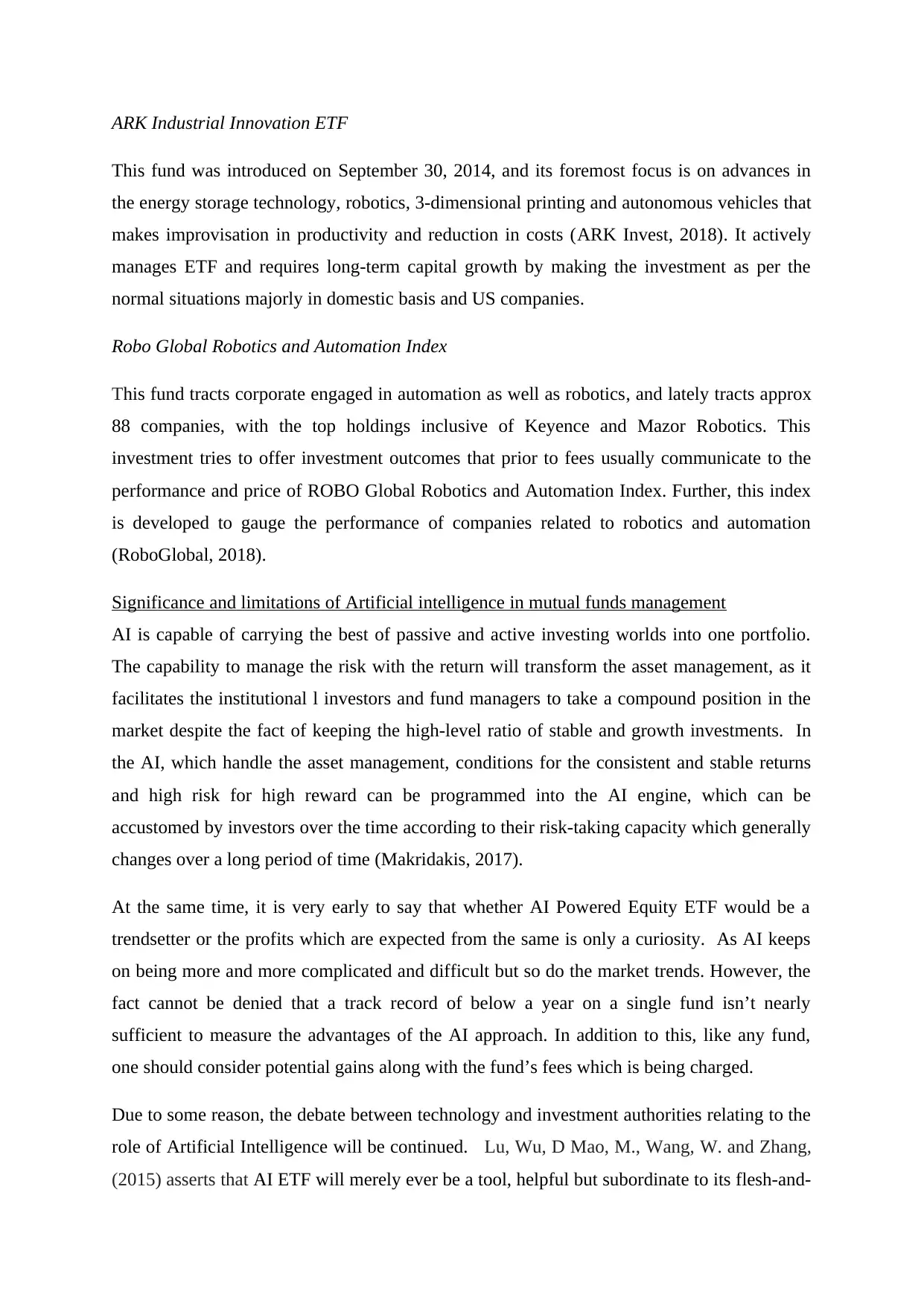
ARK Industrial Innovation ETF
This fund was introduced on September 30, 2014, and its foremost focus is on advances in
the energy storage technology, robotics, 3-dimensional printing and autonomous vehicles that
makes improvisation in productivity and reduction in costs (ARK Invest, 2018). It actively
manages ETF and requires long-term capital growth by making the investment as per the
normal situations majorly in domestic basis and US companies.
Robo Global Robotics and Automation Index
This fund tracts corporate engaged in automation as well as robotics, and lately tracts approx
88 companies, with the top holdings inclusive of Keyence and Mazor Robotics. This
investment tries to offer investment outcomes that prior to fees usually communicate to the
performance and price of ROBO Global Robotics and Automation Index. Further, this index
is developed to gauge the performance of companies related to robotics and automation
(RoboGlobal, 2018).
Significance and limitations of Artificial intelligence in mutual funds management
AI is capable of carrying the best of passive and active investing worlds into one portfolio.
The capability to manage the risk with the return will transform the asset management, as it
facilitates the institutional l investors and fund managers to take a compound position in the
market despite the fact of keeping the high-level ratio of stable and growth investments. In
the AI, which handle the asset management, conditions for the consistent and stable returns
and high risk for high reward can be programmed into the AI engine, which can be
accustomed by investors over the time according to their risk-taking capacity which generally
changes over a long period of time (Makridakis, 2017).
At the same time, it is very early to say that whether AI Powered Equity ETF would be a
trendsetter or the profits which are expected from the same is only a curiosity. As AI keeps
on being more and more complicated and difficult but so do the market trends. However, the
fact cannot be denied that a track record of below a year on a single fund isn’t nearly
sufficient to measure the advantages of the AI approach. In addition to this, like any fund,
one should consider potential gains along with the fund’s fees which is being charged.
Due to some reason, the debate between technology and investment authorities relating to the
role of Artificial Intelligence will be continued. Lu, Wu, D Mao, M., Wang, W. and Zhang,
(2015) asserts that AI ETF will merely ever be a tool, helpful but subordinate to its flesh-and-
This fund was introduced on September 30, 2014, and its foremost focus is on advances in
the energy storage technology, robotics, 3-dimensional printing and autonomous vehicles that
makes improvisation in productivity and reduction in costs (ARK Invest, 2018). It actively
manages ETF and requires long-term capital growth by making the investment as per the
normal situations majorly in domestic basis and US companies.
Robo Global Robotics and Automation Index
This fund tracts corporate engaged in automation as well as robotics, and lately tracts approx
88 companies, with the top holdings inclusive of Keyence and Mazor Robotics. This
investment tries to offer investment outcomes that prior to fees usually communicate to the
performance and price of ROBO Global Robotics and Automation Index. Further, this index
is developed to gauge the performance of companies related to robotics and automation
(RoboGlobal, 2018).
Significance and limitations of Artificial intelligence in mutual funds management
AI is capable of carrying the best of passive and active investing worlds into one portfolio.
The capability to manage the risk with the return will transform the asset management, as it
facilitates the institutional l investors and fund managers to take a compound position in the
market despite the fact of keeping the high-level ratio of stable and growth investments. In
the AI, which handle the asset management, conditions for the consistent and stable returns
and high risk for high reward can be programmed into the AI engine, which can be
accustomed by investors over the time according to their risk-taking capacity which generally
changes over a long period of time (Makridakis, 2017).
At the same time, it is very early to say that whether AI Powered Equity ETF would be a
trendsetter or the profits which are expected from the same is only a curiosity. As AI keeps
on being more and more complicated and difficult but so do the market trends. However, the
fact cannot be denied that a track record of below a year on a single fund isn’t nearly
sufficient to measure the advantages of the AI approach. In addition to this, like any fund,
one should consider potential gains along with the fund’s fees which is being charged.
Due to some reason, the debate between technology and investment authorities relating to the
role of Artificial Intelligence will be continued. Lu, Wu, D Mao, M., Wang, W. and Zhang,
(2015) asserts that AI ETF will merely ever be a tool, helpful but subordinate to its flesh-and-
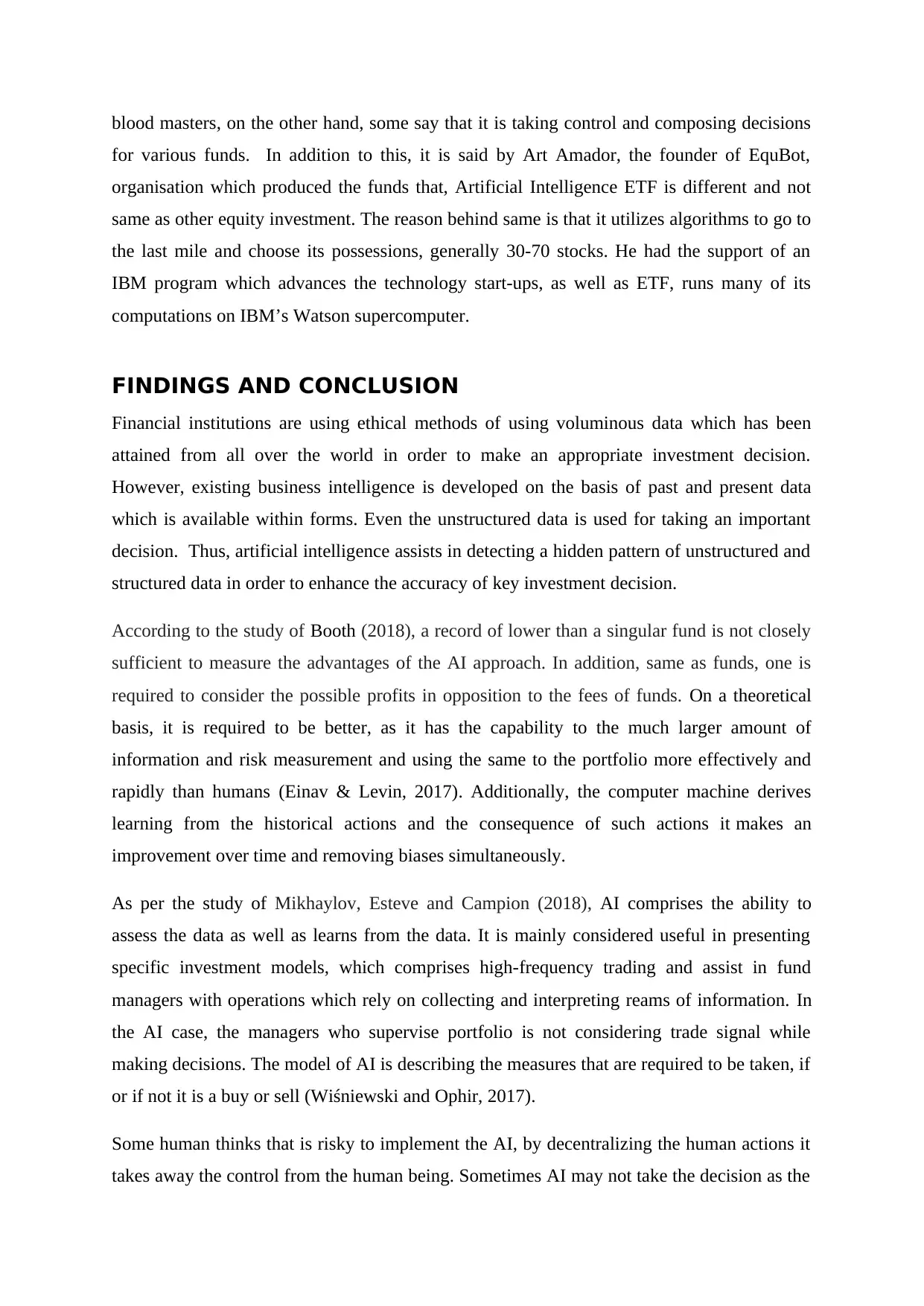
blood masters, on the other hand, some say that it is taking control and composing decisions
for various funds. In addition to this, it is said by Art Amador, the founder of EquBot,
organisation which produced the funds that, Artificial Intelligence ETF is different and not
same as other equity investment. The reason behind same is that it utilizes algorithms to go to
the last mile and choose its possessions, generally 30-70 stocks. He had the support of an
IBM program which advances the technology start-ups, as well as ETF, runs many of its
computations on IBM’s Watson supercomputer.
FINDINGS AND CONCLUSION
Financial institutions are using ethical methods of using voluminous data which has been
attained from all over the world in order to make an appropriate investment decision.
However, existing business intelligence is developed on the basis of past and present data
which is available within forms. Even the unstructured data is used for taking an important
decision. Thus, artificial intelligence assists in detecting a hidden pattern of unstructured and
structured data in order to enhance the accuracy of key investment decision.
According to the study of Booth (2018), a record of lower than a singular fund is not closely
sufficient to measure the advantages of the AI approach. In addition, same as funds, one is
required to consider the possible profits in opposition to the fees of funds. On a theoretical
basis, it is required to be better, as it has the capability to the much larger amount of
information and risk measurement and using the same to the portfolio more effectively and
rapidly than humans (Einav & Levin, 2017). Additionally, the computer machine derives
learning from the historical actions and the consequence of such actions it makes an
improvement over time and removing biases simultaneously.
As per the study of Mikhaylov, Esteve and Campion (2018), AI comprises the ability to
assess the data as well as learns from the data. It is mainly considered useful in presenting
specific investment models, which comprises high-frequency trading and assist in fund
managers with operations which rely on collecting and interpreting reams of information. In
the AI case, the managers who supervise portfolio is not considering trade signal while
making decisions. The model of AI is describing the measures that are required to be taken, if
or if not it is a buy or sell (Wiśniewski and Ophir, 2017).
Some human thinks that is risky to implement the AI, by decentralizing the human actions it
takes away the control from the human being. Sometimes AI may not take the decision as the
for various funds. In addition to this, it is said by Art Amador, the founder of EquBot,
organisation which produced the funds that, Artificial Intelligence ETF is different and not
same as other equity investment. The reason behind same is that it utilizes algorithms to go to
the last mile and choose its possessions, generally 30-70 stocks. He had the support of an
IBM program which advances the technology start-ups, as well as ETF, runs many of its
computations on IBM’s Watson supercomputer.
FINDINGS AND CONCLUSION
Financial institutions are using ethical methods of using voluminous data which has been
attained from all over the world in order to make an appropriate investment decision.
However, existing business intelligence is developed on the basis of past and present data
which is available within forms. Even the unstructured data is used for taking an important
decision. Thus, artificial intelligence assists in detecting a hidden pattern of unstructured and
structured data in order to enhance the accuracy of key investment decision.
According to the study of Booth (2018), a record of lower than a singular fund is not closely
sufficient to measure the advantages of the AI approach. In addition, same as funds, one is
required to consider the possible profits in opposition to the fees of funds. On a theoretical
basis, it is required to be better, as it has the capability to the much larger amount of
information and risk measurement and using the same to the portfolio more effectively and
rapidly than humans (Einav & Levin, 2017). Additionally, the computer machine derives
learning from the historical actions and the consequence of such actions it makes an
improvement over time and removing biases simultaneously.
As per the study of Mikhaylov, Esteve and Campion (2018), AI comprises the ability to
assess the data as well as learns from the data. It is mainly considered useful in presenting
specific investment models, which comprises high-frequency trading and assist in fund
managers with operations which rely on collecting and interpreting reams of information. In
the AI case, the managers who supervise portfolio is not considering trade signal while
making decisions. The model of AI is describing the measures that are required to be taken, if
or if not it is a buy or sell (Wiśniewski and Ophir, 2017).
Some human thinks that is risky to implement the AI, by decentralizing the human actions it
takes away the control from the human being. Sometimes AI may not take the decision as the

humans can because human considers every situation at the time of taking the decision (Bond
and Gasser, 2014).
Comparing the time spent by organizations discussing AI in their incomes calls exposes an
interesting justification of AI’s potential judged by the market. Further, it is concluded that
organizations that spent much time discussing AI in their investor earnings meeting calls
have begun to outperform those who spent less time on it, despite segment. The financial
market is treated as the human market, in which the opportunities for earning the profit exist
as the time changes, further it depends on the changing strategies of the rivals. Thus the
important thing is that the input may change over the time. The AI system should be
implemented by managing the data, its selection, asset valuation as well as portfolio
management component. The future goal of the AI system is to combine all the three
techniques such as knowledge-based system, machine learning, and natural languages
processing into the one system by which the data collection, asset management, and portfolio
management can be handled at the same time. Such a system makes the connection with the
human by interacting with them. Thus a human can specify their priorities and make the
difficult decision, however in some areas such as program trading; these complex system
could compete with each other.
and Gasser, 2014).
Comparing the time spent by organizations discussing AI in their incomes calls exposes an
interesting justification of AI’s potential judged by the market. Further, it is concluded that
organizations that spent much time discussing AI in their investor earnings meeting calls
have begun to outperform those who spent less time on it, despite segment. The financial
market is treated as the human market, in which the opportunities for earning the profit exist
as the time changes, further it depends on the changing strategies of the rivals. Thus the
important thing is that the input may change over the time. The AI system should be
implemented by managing the data, its selection, asset valuation as well as portfolio
management component. The future goal of the AI system is to combine all the three
techniques such as knowledge-based system, machine learning, and natural languages
processing into the one system by which the data collection, asset management, and portfolio
management can be handled at the same time. Such a system makes the connection with the
human by interacting with them. Thus a human can specify their priorities and make the
difficult decision, however in some areas such as program trading; these complex system
could compete with each other.
Paraphrase This Document
Need a fresh take? Get an instant paraphrase of this document with our AI Paraphraser
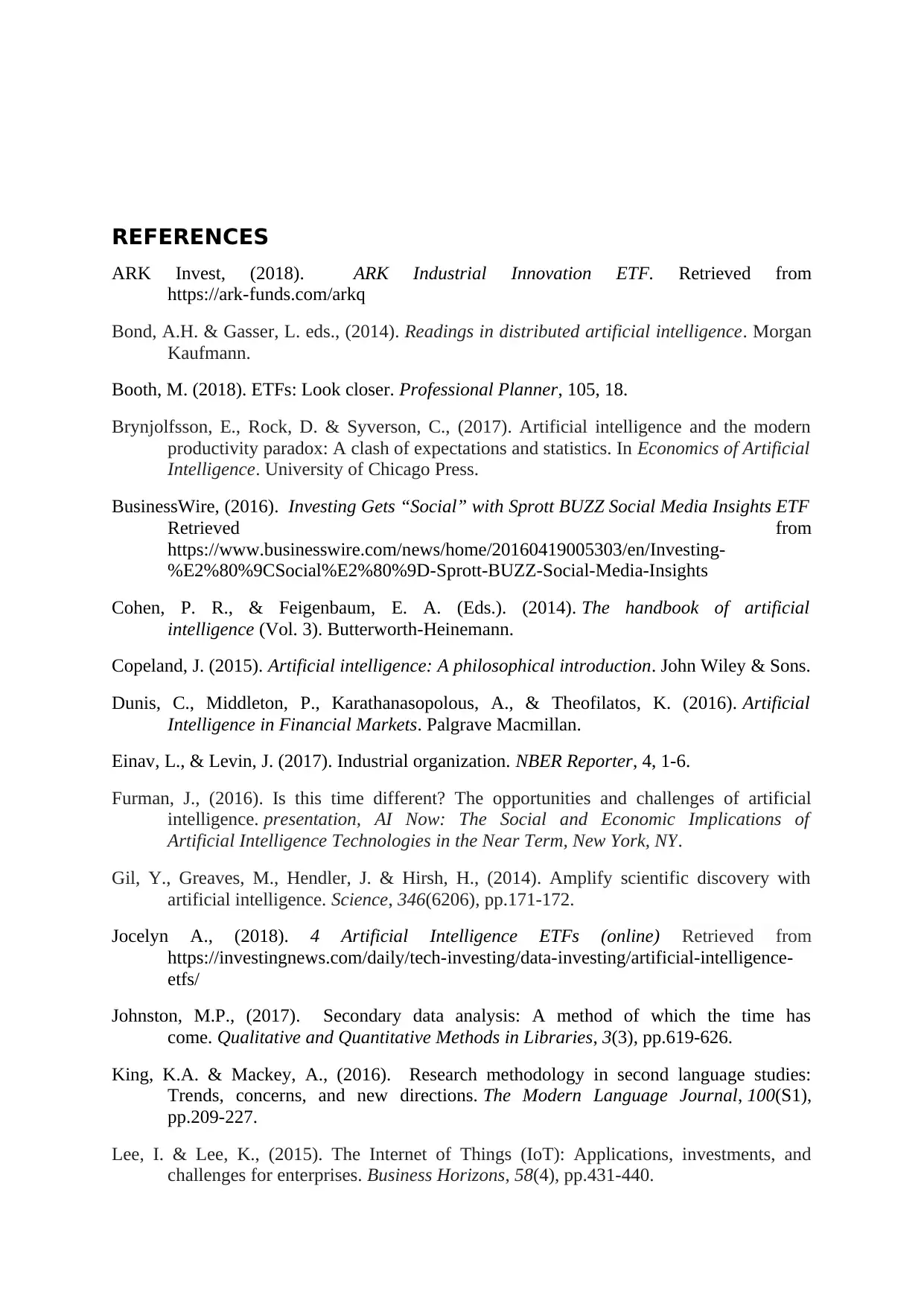
REFERENCES
ARK Invest, (2018). ARK Industrial Innovation ETF. Retrieved from
https://ark-funds.com/arkq
Bond, A.H. & Gasser, L. eds., (2014). Readings in distributed artificial intelligence. Morgan
Kaufmann.
Booth, M. (2018). ETFs: Look closer. Professional Planner, 105, 18.
Brynjolfsson, E., Rock, D. & Syverson, C., (2017). Artificial intelligence and the modern
productivity paradox: A clash of expectations and statistics. In Economics of Artificial
Intelligence. University of Chicago Press.
BusinessWire, (2016). Investing Gets “Social” with Sprott BUZZ Social Media Insights ETF
Retrieved from
https://www.businesswire.com/news/home/20160419005303/en/Investing-
%E2%80%9CSocial%E2%80%9D-Sprott-BUZZ-Social-Media-Insights
Cohen, P. R., & Feigenbaum, E. A. (Eds.). (2014). The handbook of artificial
intelligence (Vol. 3). Butterworth-Heinemann.
Copeland, J. (2015). Artificial intelligence: A philosophical introduction. John Wiley & Sons.
Dunis, C., Middleton, P., Karathanasopolous, A., & Theofilatos, K. (2016). Artificial
Intelligence in Financial Markets. Palgrave Macmillan.
Einav, L., & Levin, J. (2017). Industrial organization. NBER Reporter, 4, 1-6.
Furman, J., (2016). Is this time different? The opportunities and challenges of artificial
intelligence. presentation, AI Now: The Social and Economic Implications of
Artificial Intelligence Technologies in the Near Term, New York, NY.
Gil, Y., Greaves, M., Hendler, J. & Hirsh, H., (2014). Amplify scientific discovery with
artificial intelligence. Science, 346(6206), pp.171-172.
Jocelyn A., (2018). 4 Artificial Intelligence ETFs (online) Retrieved from
https://investingnews.com/daily/tech-investing/data-investing/artificial-intelligence-
etfs/
Johnston, M.P., (2017). Secondary data analysis: A method of which the time has
come. Qualitative and Quantitative Methods in Libraries, 3(3), pp.619-626.
King, K.A. & Mackey, A., (2016). Research methodology in second language studies:
Trends, concerns, and new directions. The Modern Language Journal, 100(S1),
pp.209-227.
Lee, I. & Lee, K., (2015). The Internet of Things (IoT): Applications, investments, and
challenges for enterprises. Business Horizons, 58(4), pp.431-440.
ARK Invest, (2018). ARK Industrial Innovation ETF. Retrieved from
https://ark-funds.com/arkq
Bond, A.H. & Gasser, L. eds., (2014). Readings in distributed artificial intelligence. Morgan
Kaufmann.
Booth, M. (2018). ETFs: Look closer. Professional Planner, 105, 18.
Brynjolfsson, E., Rock, D. & Syverson, C., (2017). Artificial intelligence and the modern
productivity paradox: A clash of expectations and statistics. In Economics of Artificial
Intelligence. University of Chicago Press.
BusinessWire, (2016). Investing Gets “Social” with Sprott BUZZ Social Media Insights ETF
Retrieved from
https://www.businesswire.com/news/home/20160419005303/en/Investing-
%E2%80%9CSocial%E2%80%9D-Sprott-BUZZ-Social-Media-Insights
Cohen, P. R., & Feigenbaum, E. A. (Eds.). (2014). The handbook of artificial
intelligence (Vol. 3). Butterworth-Heinemann.
Copeland, J. (2015). Artificial intelligence: A philosophical introduction. John Wiley & Sons.
Dunis, C., Middleton, P., Karathanasopolous, A., & Theofilatos, K. (2016). Artificial
Intelligence in Financial Markets. Palgrave Macmillan.
Einav, L., & Levin, J. (2017). Industrial organization. NBER Reporter, 4, 1-6.
Furman, J., (2016). Is this time different? The opportunities and challenges of artificial
intelligence. presentation, AI Now: The Social and Economic Implications of
Artificial Intelligence Technologies in the Near Term, New York, NY.
Gil, Y., Greaves, M., Hendler, J. & Hirsh, H., (2014). Amplify scientific discovery with
artificial intelligence. Science, 346(6206), pp.171-172.
Jocelyn A., (2018). 4 Artificial Intelligence ETFs (online) Retrieved from
https://investingnews.com/daily/tech-investing/data-investing/artificial-intelligence-
etfs/
Johnston, M.P., (2017). Secondary data analysis: A method of which the time has
come. Qualitative and Quantitative Methods in Libraries, 3(3), pp.619-626.
King, K.A. & Mackey, A., (2016). Research methodology in second language studies:
Trends, concerns, and new directions. The Modern Language Journal, 100(S1),
pp.209-227.
Lee, I. & Lee, K., (2015). The Internet of Things (IoT): Applications, investments, and
challenges for enterprises. Business Horizons, 58(4), pp.431-440.
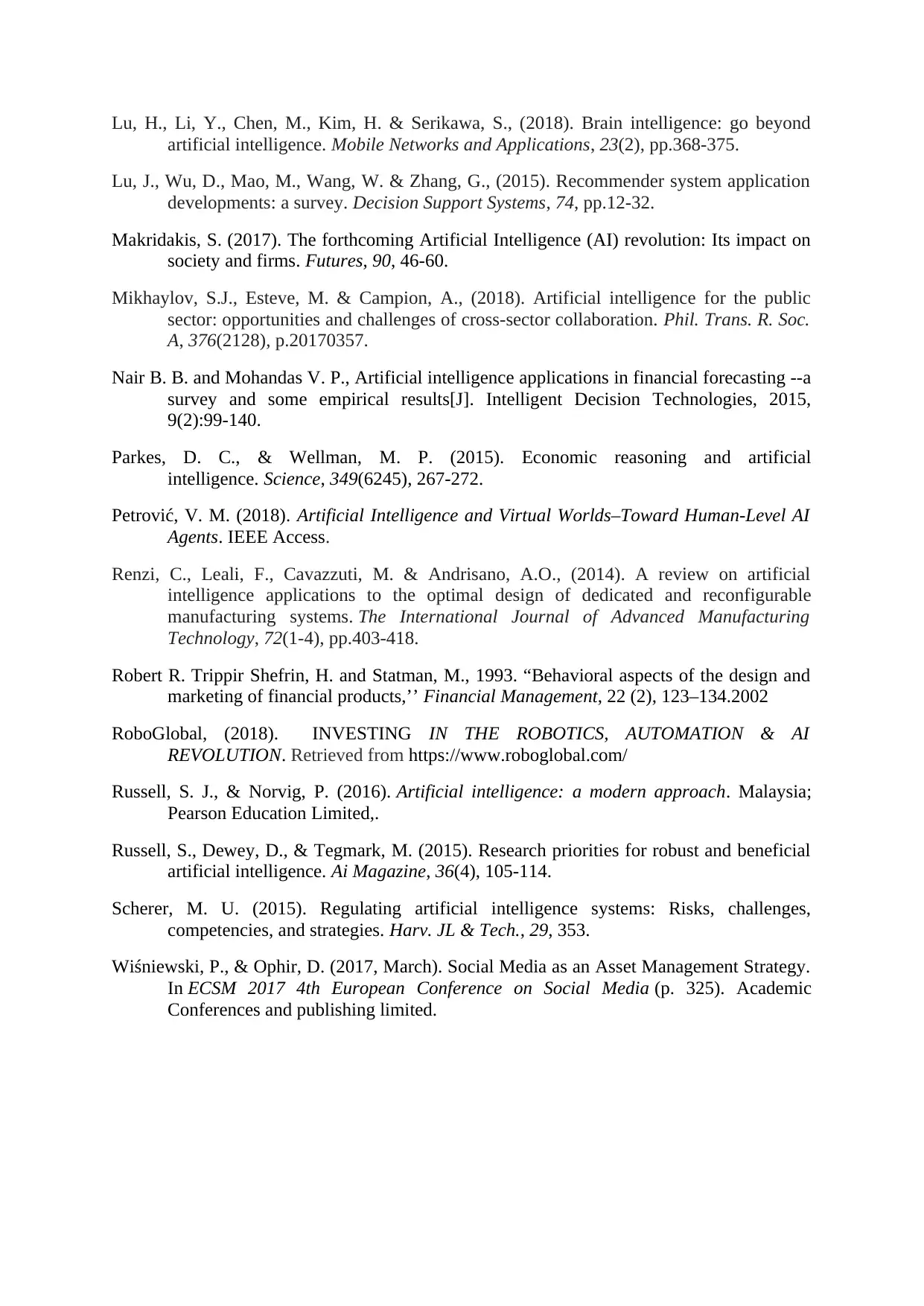
Lu, H., Li, Y., Chen, M., Kim, H. & Serikawa, S., (2018). Brain intelligence: go beyond
artificial intelligence. Mobile Networks and Applications, 23(2), pp.368-375.
Lu, J., Wu, D., Mao, M., Wang, W. & Zhang, G., (2015). Recommender system application
developments: a survey. Decision Support Systems, 74, pp.12-32.
Makridakis, S. (2017). The forthcoming Artificial Intelligence (AI) revolution: Its impact on
society and firms. Futures, 90, 46-60.
Mikhaylov, S.J., Esteve, M. & Campion, A., (2018). Artificial intelligence for the public
sector: opportunities and challenges of cross-sector collaboration. Phil. Trans. R. Soc.
A, 376(2128), p.20170357.
Nair B. B. and Mohandas V. P., Artificial intelligence applications in financial forecasting --a
survey and some empirical results[J]. Intelligent Decision Technologies, 2015,
9(2):99-140.
Parkes, D. C., & Wellman, M. P. (2015). Economic reasoning and artificial
intelligence. Science, 349(6245), 267-272.
Petrović, V. M. (2018). Artificial Intelligence and Virtual Worlds–Toward Human-Level AI
Agents. IEEE Access.
Renzi, C., Leali, F., Cavazzuti, M. & Andrisano, A.O., (2014). A review on artificial
intelligence applications to the optimal design of dedicated and reconfigurable
manufacturing systems. The International Journal of Advanced Manufacturing
Technology, 72(1-4), pp.403-418.
Robert R. Trippir Shefrin, H. and Statman, M., 1993. “Behavioral aspects of the design and
marketing of financial products,’’ Financial Management, 22 (2), 123–134.2002
RoboGlobal, (2018). INVESTING IN THE ROBOTICS, AUTOMATION & AI
REVOLUTION. Retrieved from https://www.roboglobal.com/
Russell, S. J., & Norvig, P. (2016). Artificial intelligence: a modern approach. Malaysia;
Pearson Education Limited,.
Russell, S., Dewey, D., & Tegmark, M. (2015). Research priorities for robust and beneficial
artificial intelligence. Ai Magazine, 36(4), 105-114.
Scherer, M. U. (2015). Regulating artificial intelligence systems: Risks, challenges,
competencies, and strategies. Harv. JL & Tech., 29, 353.
Wiśniewski, P., & Ophir, D. (2017, March). Social Media as an Asset Management Strategy.
In ECSM 2017 4th European Conference on Social Media (p. 325). Academic
Conferences and publishing limited.
artificial intelligence. Mobile Networks and Applications, 23(2), pp.368-375.
Lu, J., Wu, D., Mao, M., Wang, W. & Zhang, G., (2015). Recommender system application
developments: a survey. Decision Support Systems, 74, pp.12-32.
Makridakis, S. (2017). The forthcoming Artificial Intelligence (AI) revolution: Its impact on
society and firms. Futures, 90, 46-60.
Mikhaylov, S.J., Esteve, M. & Campion, A., (2018). Artificial intelligence for the public
sector: opportunities and challenges of cross-sector collaboration. Phil. Trans. R. Soc.
A, 376(2128), p.20170357.
Nair B. B. and Mohandas V. P., Artificial intelligence applications in financial forecasting --a
survey and some empirical results[J]. Intelligent Decision Technologies, 2015,
9(2):99-140.
Parkes, D. C., & Wellman, M. P. (2015). Economic reasoning and artificial
intelligence. Science, 349(6245), 267-272.
Petrović, V. M. (2018). Artificial Intelligence and Virtual Worlds–Toward Human-Level AI
Agents. IEEE Access.
Renzi, C., Leali, F., Cavazzuti, M. & Andrisano, A.O., (2014). A review on artificial
intelligence applications to the optimal design of dedicated and reconfigurable
manufacturing systems. The International Journal of Advanced Manufacturing
Technology, 72(1-4), pp.403-418.
Robert R. Trippir Shefrin, H. and Statman, M., 1993. “Behavioral aspects of the design and
marketing of financial products,’’ Financial Management, 22 (2), 123–134.2002
RoboGlobal, (2018). INVESTING IN THE ROBOTICS, AUTOMATION & AI
REVOLUTION. Retrieved from https://www.roboglobal.com/
Russell, S. J., & Norvig, P. (2016). Artificial intelligence: a modern approach. Malaysia;
Pearson Education Limited,.
Russell, S., Dewey, D., & Tegmark, M. (2015). Research priorities for robust and beneficial
artificial intelligence. Ai Magazine, 36(4), 105-114.
Scherer, M. U. (2015). Regulating artificial intelligence systems: Risks, challenges,
competencies, and strategies. Harv. JL & Tech., 29, 353.
Wiśniewski, P., & Ophir, D. (2017, March). Social Media as an Asset Management Strategy.
In ECSM 2017 4th European Conference on Social Media (p. 325). Academic
Conferences and publishing limited.

1 out of 16
Related Documents
Your All-in-One AI-Powered Toolkit for Academic Success.
+13062052269
info@desklib.com
Available 24*7 on WhatsApp / Email
![[object Object]](/_next/static/media/star-bottom.7253800d.svg)
Unlock your academic potential
© 2024 | Zucol Services PVT LTD | All rights reserved.





